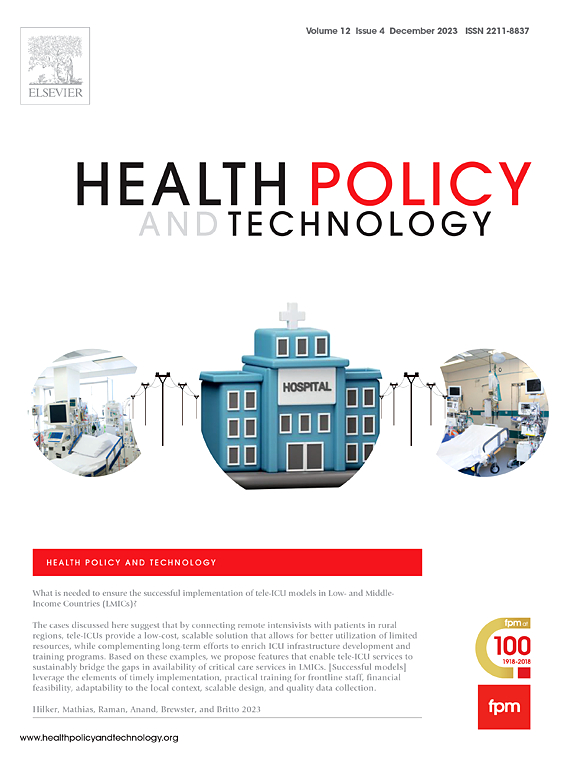量化制药和医疗器械行业-医生的财务关系:2019年至2021年日本医学协会领导层的酬金支付分析
IF 3.7
3区 医学
Q1 HEALTH POLICY & SERVICES
引用次数: 0
摘要
目的评估制药和医疗器械行业向医疗协会领导支付酬金的程度和分布,增强我们对日本行业-医生财务关系的了解。方法回顾性分析日本医药工业协会所属制药公司和医疗器械网络所属医疗器械公司公开披露的支付数据。数据涵盖了2019年至2021年期间向18个主要专业医学协会董事会成员支付的演讲、写作和咨询酬金。结果在399名执行董事会成员中,373名(93.5%)获得了总计1599万美元的薪酬。每位会员在三年内支付的中位数为22,529美元(四分位数区间[IQR]为7230.8美元至57,223.9美元)。付款集中在四个专业医学协会,分别代表内科(297万美元)、眼科(178万美元)、皮肤科(178万美元)和泌尿科(187万美元),占总数的52.5%。外科专业从医疗器械公司获得的付款比例较高,而非外科专业-制药公司。在2019冠状病毒病大流行期间,支付额在2020年下降,到2021年恢复。18家协会的领导层都没有公开披露其董事会成员的财务关系。我们发现日本的行业和医疗协会领导层之间存在广泛而集中的联系,制药和医疗器械行业各自表现出独特的支付模式。该协会所显示的巨额支付和有限的透明度凸显了法律强制披露的迫切需要,包括专门的解决方案。本文章由计算机程序翻译,如有差异,请以英文原文为准。
Quantifying pharmaceutical and medical device industry-physician financial ties: An analysis of honorarium payments to Japanese medical association leadership between 2019 and 2021
Objective
To assess the extent and distribution of pharmaceutical and medical device industry honorarium payments to medical association leadership, enhancing our understanding of industry-physician financial ties in Japan.
Methods
We conducted a retrospective analysis of publicly disclosed payment data from pharmaceutical companies affiliated with the Japan Pharmaceutical Manufacturers Association and medical device companies affiliated with the Medical Devices Network. Data covered honorarium payments for speaking, writing, and consulting to board members of 18 major professional medical associations from 2019 to 2021.
Results
Of the 399 executive board members, 373 (93.5 %) received payments totaling $15.99 million. The median payment per member over the three years was $22,529, (interquartile range [IQR], $7230.8–$57,223.9). Payments were concentrated, with four professional medical associations—representing Internal Medicine ($2.97 million), Ophthalmology ($1.78 million), Dermatology ($1.78 million), and Urology ($1.87 million)—accounting for 52.5 % of the total. Surgical specialties received a higher proportion of payments from medical device companies, while non-surgical specialties – pharmaceutical companies. Payments declined in 2020, coinciding with the COVID-19 pandemic, recovering by 2021. None of the 18 associations' leadership publicly disclosed their board members' financial ties.
Conclusions
We found extensive and concentrated ties between industry and medical association leadership in Japan, with the pharmaceutical and medical device sectors each displaying distinctive payment patterns. The substantial scale of payments and limited transparency displayed by the association highlight the urgent need for legally mandated disclosure, including specialty-specific solutions.
求助全文
通过发布文献求助,成功后即可免费获取论文全文。
去求助
来源期刊

Health Policy and Technology
Medicine-Health Policy
CiteScore
9.20
自引率
3.30%
发文量
78
审稿时长
88 days
期刊介绍:
Health Policy and Technology (HPT), is the official journal of the Fellowship of Postgraduate Medicine (FPM), a cross-disciplinary journal, which focuses on past, present and future health policy and the role of technology in clinical and non-clinical national and international health environments.
HPT provides a further excellent way for the FPM to continue to make important national and international contributions to development of policy and practice within medicine and related disciplines. The aim of HPT is to publish relevant, timely and accessible articles and commentaries to support policy-makers, health professionals, health technology providers, patient groups and academia interested in health policy and technology.
Topics covered by HPT will include:
- Health technology, including drug discovery, diagnostics, medicines, devices, therapeutic delivery and eHealth systems
- Cross-national comparisons on health policy using evidence-based approaches
- National studies on health policy to determine the outcomes of technology-driven initiatives
- Cross-border eHealth including health tourism
- The digital divide in mobility, access and affordability of healthcare
- Health technology assessment (HTA) methods and tools for evaluating the effectiveness of clinical and non-clinical health technologies
- Health and eHealth indicators and benchmarks (measure/metrics) for understanding the adoption and diffusion of health technologies
- Health and eHealth models and frameworks to support policy-makers and other stakeholders in decision-making
- Stakeholder engagement with health technologies (clinical and patient/citizen buy-in)
- Regulation and health economics
 求助内容:
求助内容: 应助结果提醒方式:
应助结果提醒方式:


